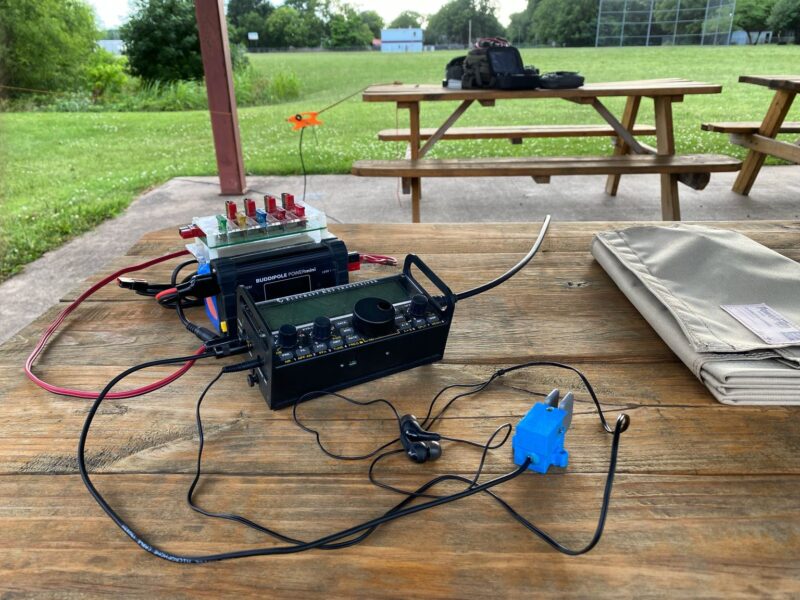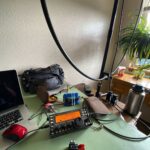
Field Day 2021 was different than the last two years. The previous years involved an expedition to a relatively remote location. The expedition involved significant planning and preparation to ensure everything needed (for both radio and camp) were assembled and loaded into the rig/camper. Once at the operation point, we setup camp and stations far from the noise of civilization. There was much fun and fellowship.
This year I was in Springfield, Missouri, visiting family. I had no plan. I did not even know if I wanted to do any radio activities so far from my friends. After waffling about what I should do, I elected to visit the Southwest Missouri Amateur Radio Club (SMARC).
But first, I need to present a little backstory.
While in Springfield, I programmed two of the local repeaters into my HT — the SMARC repeater and the Nixa Radio Club repeater. Older Son, who has a license, told me he tried several repeaters and did not hear much traffic, with the exception of a Skywarn net during a heavy thunderstorm.
After programming my HT, I regularly listened for traffic and heard little. When in the 4Runner, I called on both repeaters to see if anyone was monitoring them. I knew my programming was good because I could hear the repeater radio respond to my transmission. What I learned is that these repeaters are not heavily used. More on that below.
I checked into the Friday evening SMARC net. There were a few stations checking into the net, but even Net Control remarked that traffic was light. However, Net Control took my call and asked a me a few questions. He was curious about my visit and my background. He also invited me to attend their Field Day operation. It was to be held at the Salvation Army gymnasium not far from my kids’ place.
Saturday morning, I took Sera and we navigated to the Salvation Army gymnasium. When I arrived, I gave Sera a little time to sniff around and eliminate. (I did police up after her.) Then we entered the gym and looked around. There were about dozen folks inside, some working and some just chatting. An additional dozen personnel were outside wrangling a couple of multiband beam antennas.
No one greeted me. No one asked me to pitch in to help and showed me where. I was not quite an invisible person, but close.
After trying to start a couple of conversations without success, Sera and I stepped back outside where we surveyed the scene. The two groups wrangling beam antennas were still wrestling with their prey. Another group started erecting a vertical antenna. A young man was working on a wire antenna. He was raising a fan dipole for the 40m, 20m, 15m, and 10m bands using a hitch-mounted telescoping mast. (I thought “Ah, a portable operator.”) He introduced himself as Mike, but I cannot remember his callsign. I helped with one end of the antenna and another person pitched in on the other end. We helped Mike get his antenna deployed and then joined him in the gym where he began assembling his station.
Mike was personable and engaging. He is an active Parks on the Air (POTA) activator and often operates portable. He is a doer.
I didn’t get the other young man’s name, but he works in the SKYWARN (storm spotter) network. He needs his General license and wants to get it. He is also a doer.
After giving Mike a ride to a nearby convenience store to get a drink and some lunch, Sera and I met the kids for lunch at a local Italian restaurant. I really like it and will visit again. Then we returned to the gym to see what was up.
There was not much. Mike was one of three operators who were working the bands and was focused on what he was doing. So, Sera and I left the building and walked the perimeter of the large field adjacent to the gym building.
When we returned to the parking lot, we found another ham, Patrick, assembling a portable antenna. He uses a vertical wire either wrapped around a Black Widow mast or suspended from a tree limb. He uses one of two low power radios (QRP rigs). As he prepared to setup his station in the back seat of his vehicle, I asked him if he thought the pavilion with a roof and shade might be more comfortable than the back seat of his vehicle.
“Maybe,” he said.
I moved my rig near the pavilion and then got out my Elecraft KX2, a telescoping mast, my end-fed halfwave antenna, and a battery. I had my station set up in about fifteen minutes. Patrick was working on his as well. He had moved to the pavilion.
“I won’t bother you will I?” he asked.
“No, I often operator portable with other operators.”
“Do you have a log?” he asked, “I’m going to see if I can get some sheets of paper to keep my log.”
“I think I’ll use my iPhone. I don’t think I’ll make that many contacts.”
I ran my KX2 at about 10w. I started searching and pouncing and after a couple of hours had 15 contacts or so. It wasn’t bad.
Now and again I heard Patrick transmitting or one of the stations inside the gym on my radio. But there was not a lot of interference.
I decided to walk Sera around the perimeter again before calling it a day. Patrick offered to watch my rig while I walked.
As we walked along the back lot line of the nearby houses, three dogs ran up to their fence aggressively and Sera got away from me. When she turned to respond to me, one of them nailed her hip through the fence. If I had realized that it got her, I would have kicked its teeth in. I should have carried my pepper spray and hosed them down.
Tired, soaked to the skin from the humidity, and hungry, we returned to the pavilion and I tore down my station. I said good evening to Patrick and Mike and we headed home.
On the way home, I heard an operator call on the Nixa repeater asking for help with the Field Day exchange. No local ham answered his call. He called again and no one answered. So I answered his call and we had a nice chat. He had been away from the HF bands for awhile and wanted to play during Field Day. But he could not figure out the exchange and was having trouble navigating the ARRL website. I think I got him straightened out. At least he had an idea of what to do.

I sat at my Elecraft KX3 station running 15 watts into a magnetic loop antenna. I tried several times on previous days to raise a call, but no one answered my call on any band that I tried. Sunday morning I worked another slug of stations with the KX3. I logged my contacts on my iPhone as they were made. I quit about 1000h local.
On Monday morning I moved all of my contacts (36 of them) to my computer. Then I prepared the log for submission to ARRL as my contribution to Field Day. It was quite different than my previous Field Days, yet I still had fun — even with the disappointment in the club.
I learned a few things again this year.
- Amateur radio clubs are their own worst enemies. Survival of the service requires new people participating. New operators need a community where they can receive instruction (answers to questions as well as more formal work) and fellowship. They need a place to belong.
- Clubs that don’t dedicate personnel to capture new people and greet visitors are not going to add members. This is a critical issue to bringing in new operators and getting them active on the bands.
- I still have work to do on my Morse code skills. I was uncomfortable with the idea of running a frequency. I would have made more contacts if I had. I still had fun and it was challenging.
- It’s a good idea to have a computer that can run logging software and reads data from the radio. A phone logging program can be used, but all the data fields have to be entered manually. N1MM+ will read the radio if connected via USB. Even a low power Windows computer can run N1MM+.
- I was not prepared for this Field Day. Normally I prepare a few weeks in advance. I have my station organized, know what I am going to use and what I am going to do, and I have the rules and supporting material printed and in a notebook for reference. Still, I had fun and made a few contacts. So it ended well.
Next year will be different again, I suspect. I am sure I will learn more on the next Field Day.